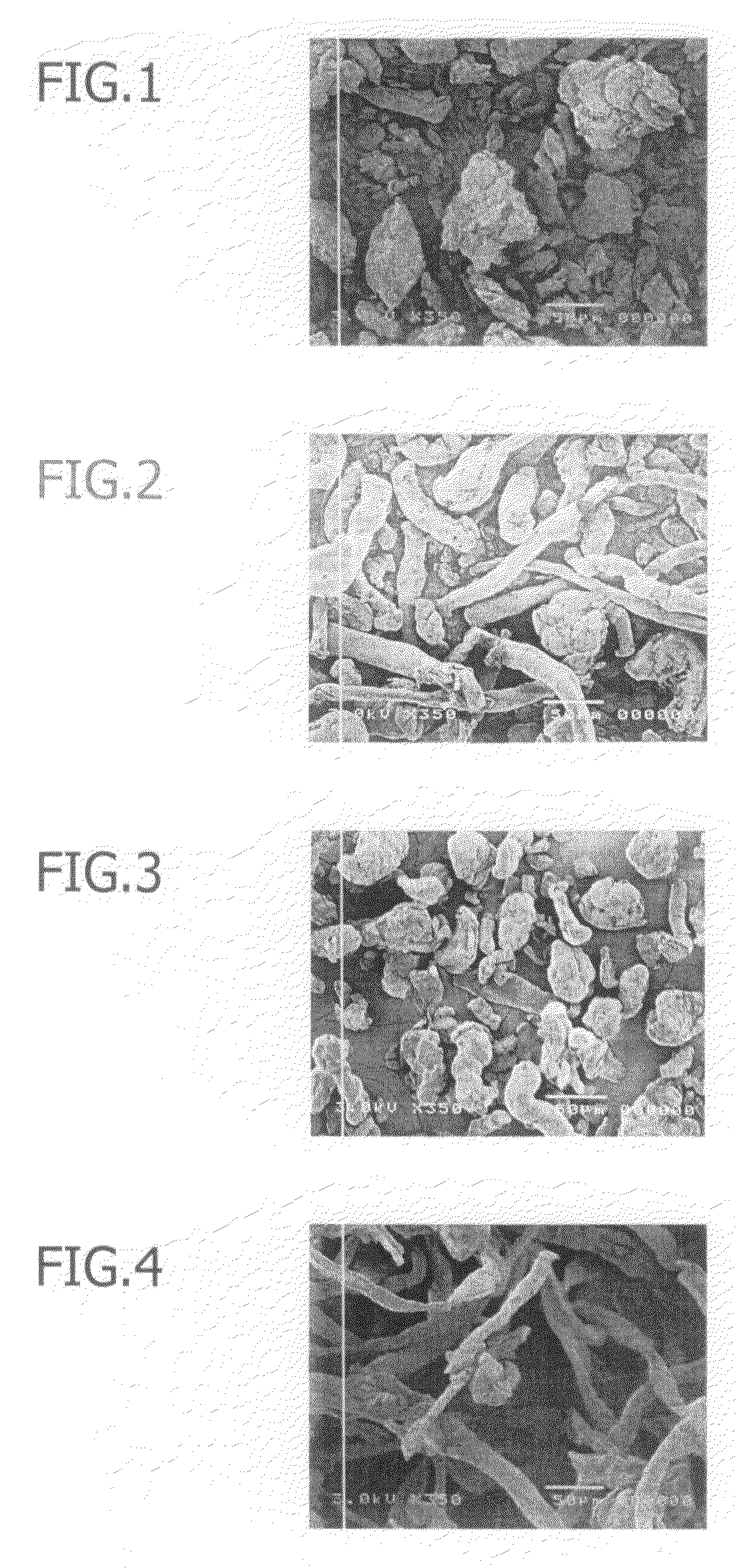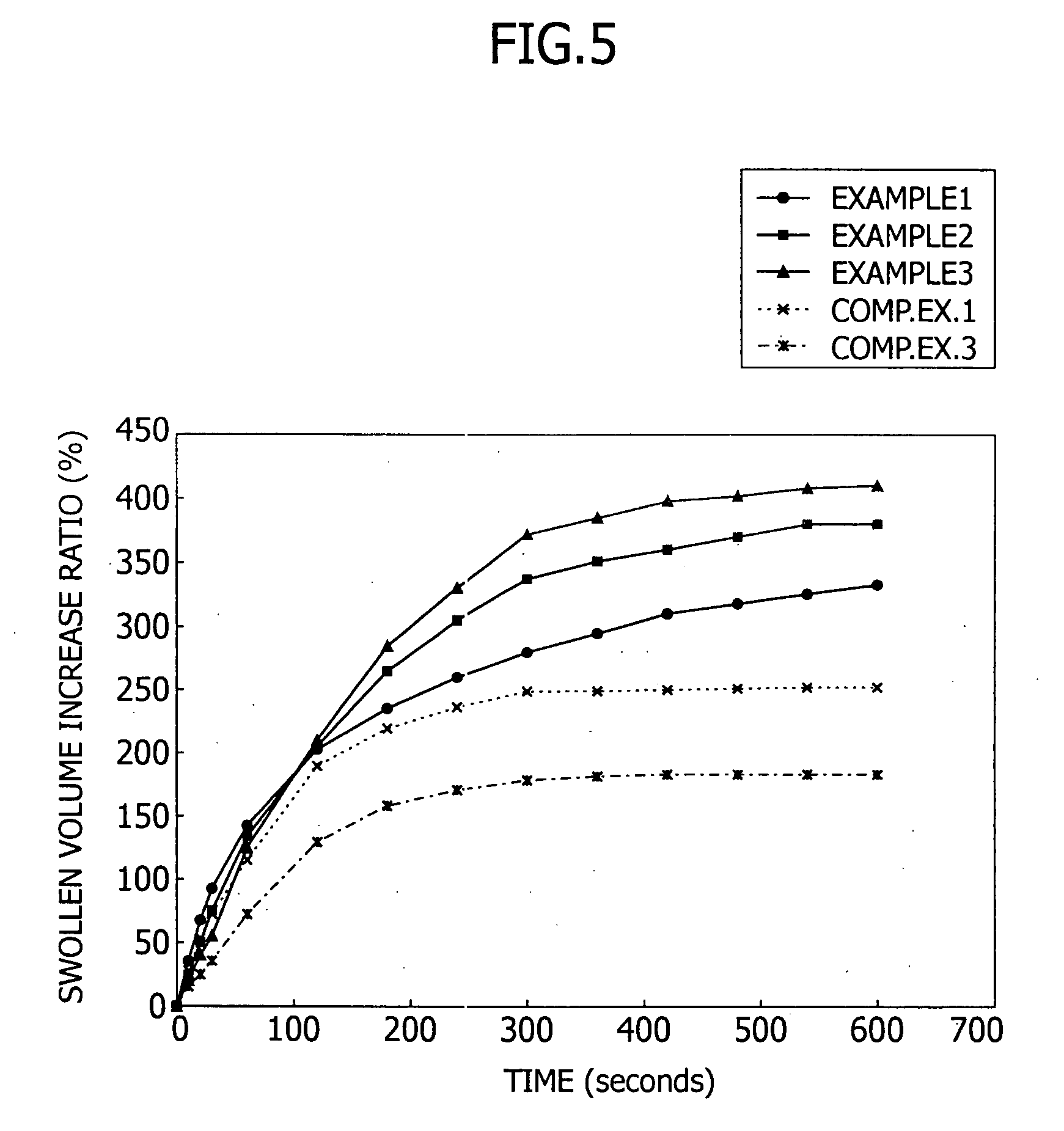Low-substituted hydroxypropylcellulose powder and method for producing the same
a technology of hydroxypropylcellulose and hydroxypropylcellulose, which is applied in the directions of thin material processing, transportation and packaging, pill delivery, etc., can solve the problems of excessive aqueous sodium hydroxide solution absorbed by the pulp, insufficient drug action, and inability to keep the shape of the tablet or granule produced therefrom, etc., to achieve excellent compressibility, excellent swelling properties, and high flowability
- Summary
- Abstract
- Description
- Claims
- Application Information
AI Technical Summary
Benefits of technology
Problems solved by technology
Method used
Image
Examples
example 1
[0083]First, 806 g of powdered pulp (750 g in an anhydrous state) was charged into a 10 L internally-agitating type reaction device, 303 g of 26% by weight sodium hydroxide solution was charged into the reaction device, then mixing was performed at 45° C. for 30 minutes, and thus alkali cellulose was obtained in which the weight ratio of sodium hydroxide with respect to anhydrous cellulose was 0.105. Next, nitrogen purge was performed, 123 g of propylene oxide (0.164 parts by weight with respect to cellulose) was added to the resultant, then the mixture was reacted at a jacket temperature of 60° C. for 1.5 hours, and thus 1232 g of hydroxypropylcellulose crude reaction product was obtained in which the molar substitution number of hydroxypropoxyl groups per anhydrous glucose unit was 0.28. The etherification efficiency was 61.4%.
[0084]Next, 236 g of 50% by weight acetic acid was added and mixed in the 10 L internally-agitating type reaction device, thereby performing neutralization....
example 2
[0108]First, 806 g of powdered pulp (750 g in an anhydrous state) was charged into a 10 L internally-agitating type reaction device, 504 g of 26% by weight sodium hydroxide solution was charged into the reaction device, then mixing was performed at 45° C. for 30 minutes, and thus alkali cellulose was obtained in which the weight ratio of sodium hydroxide with respect to anhydrous cellulose was 0.175. Next, nitrogen purge was performed, 143 g of propylene oxide (0.190 parts by weight with respect to cellulose) was added to the resultant, then the mixture was reacted at a jacket temperature of 60° C. for 1.5 hours, and thus 1453 g of hydroxypropylcellulose crude reaction product was obtained in which a molar substitution number of hydroxypropoxyl groups per anhydrous glucose unit was 0.29. The etherification efficiency was 53.6%.
[0109]Next, 394 g of 50% by weight acetic acid was added and mixed in the 10 L internally-agitating type reaction device, thereby performing neutralization. T...
example 3
[0112]First, 806 g of powdered pulp (750 g in an anhydrous state) was charged into a 10 L internally-agitating type reaction device, 808 g of 26% by weight sodium hydroxide solution was charged into the reaction device, then mixing was performed at 45° C. for 30 minutes, and thus alkali cellulose was obtained in which the weight ratio of sodium hydroxide with respect to anhydrous cellulose was 0.280. Next, nitrogen purge was performed, 173 g of propylene oxide (0.230 parts by weight with respect to cellulose) was added to the resultant, then the mixture was reacted at a jacket temperature of 60° C. for 1.5 hours, and thus 1787 g of hydroxypropylcellulose crude reaction product was obtained in which a molar substitution number of hydroxypropoxyl groups per anhydrous glucose unit was 0.30. The etherification efficiency was 46.4%.
[0113]Next, 629 g of 50% by weight acetic acid was added and mixed in the 10 L internally-agitating type reaction device, thereby performing neutralization. T...
PUM
| Property | Measurement | Unit |
|---|---|---|
| weight ratio | aaaaa | aaaaa |
| specific surface area | aaaaa | aaaaa |
| particle size | aaaaa | aaaaa |
Abstract
Description
Claims
Application Information
 Login to View More
Login to View More - R&D
- Intellectual Property
- Life Sciences
- Materials
- Tech Scout
- Unparalleled Data Quality
- Higher Quality Content
- 60% Fewer Hallucinations
Browse by: Latest US Patents, China's latest patents, Technical Efficacy Thesaurus, Application Domain, Technology Topic, Popular Technical Reports.
© 2025 PatSnap. All rights reserved.Legal|Privacy policy|Modern Slavery Act Transparency Statement|Sitemap|About US| Contact US: help@patsnap.com



